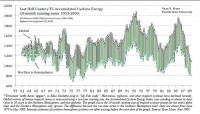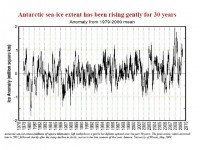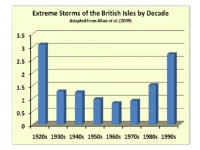By Piers Corbyn, WeatherAction
“It should be ignored absolutely. The opposite to whatever the Met Office says in long range has been what happened for the last three years!” Piers Corbyn, astrophysicist of WeatherAction said today, 23 July:
“The Met Office long range forecast attempts at seasonal and world developments totally failed to predict ANY of the 5 notable weather developments since 2007. They predicted the opposite to what occurred for the wet summers 2007, 2008, and 2009, the icy snowy winter 2008/09, and world temperature decline over recent years. On the other hand our WeatherAction Solar Weather Technique predicted all these major situations correctly and did it ahead of the Met Office prognoses.
Their score of zero out of five is lamentable. It could not be worse. They should stop issuing these reckless ‘forecasts’ which only serve to mislead the public, commerce and emergency authorities and cause unnecessary misery danger and possible death.
Their forecast for a mild winter in 08/09 disarmed the emergency services and Councils and led directly to the UK running out of road salt, transport chaos and extra road accidents when the snow deluges predicted by us at WeatherAction hit Britain and Ireland. The Met Office stupidity cost the economy billions of pounds. “The recent heavy rains and weather prospects spell failure for the Met Office forecast of a ‘barbecue summer’ which we advised our own forecast users would fail. For how much longer will government, ‘opposition’ and much of commerce continue to follow failed methodology which is without scientific basis?
“The Met Office long range forecasts will continue to fail because they are founded on the politically motivated false theory of man-made global warming and related computer models. The fact is the world has been cooling for at least 7 years while CO2 has been rapidly rising. Our proven science explains why and shows the world cooling will generally continue at least to 2030 and the world will remain generally cooler than recently for a hundred years (see more here and here).
“The Met Office ‘forecast’ (issued 23 July) for winter 2009-10 to be probably milder and wetter than average is nonsense and entirely what one would expect them to say. Their religious belief in non-existent man-made Global Warming means they could not say anything different. Their forecast should be ignored absolutely. Statistically speaking the opposite to what they say has a success score of 5/5.
“In the immediate future I suggest the major clothing chains should consider sue-ing the Met Office for misleading advise 3 years running which is now leaving stacks of ‘barbecue summer’ wear falling onto the streets. And anyone who had an accident in winter because road-salt ran out should sue the Met Office and the local Council for negligence.
“Politicians of all the major parties should be called to account for their promotion of projects spending and taxation for the green bubble of false value which is the ideological basis for these stupid and damaging forecasts. Gordon Brown’s welcome moves to more accountability of public life are being undermined by the green fools who mis-advise him on environmental matters and he should get rid of them. The dead hand of the promoters of climate hysteria is causing needless economic and personal suffering and unless stopped it will end in tears and leave us all worse off”.
By Kenneth Chang, New York Times
The Sun is still blank (mostly). Ever since Samuel Heinrich Schwabe, a German astronomer, first noted in 1843 that sunspots burgeon and wane over a roughly 11-year cycle, scientists have carefully watched the Sun’s activity. In the latest lull, the Sun should have reached its calmest, least pockmarked state last fall.
Indeed, last year marked the blankest year of the Sun in the last half-century - 266 days with not a single sunspot visible from Earth. Then, in the first four months of 2009, the Sun became even more blank, the pace of sunspots slowing more. “It’s been as dead as a doornail,” David Hathaway, a solar physicist at NASA’s Marshall Space Flight Center in Huntsville, Ala., said a couple of months ago.

Most yearly sunspotless days since 1849. 2009 through July 20, 2009. 2009 is likely to enter the top dozen years along with 2007 and 2008. So far this minimum has had 663 spotless days according to spacweather.com as of July 20.
The Sun perked up in June and July, with a sizeable clump of 20 sunspots earlier this month. Now it is blank again, consistent with expectations that this solar cycle will be smaller and calmer, and the maximum of activity, expected to arrive in May 2013 will not be all that maximum. For operators of satellites and power grids, that is good news. The same roiling magnetic fields that generate sunspot blotches also accelerate a devastating rain of particles that can overload and wreck electronic equipment in orbit or on Earth.
A panel of 12 scientists assembled by the National Oceanic and Atmospheric Administration now predicts that the May 2013 peak will average 90 sunspots during that month. That would make it the weakest solar maximum since 1928, which peaked at 78 sunspots. During an average solar maximum, the Sun is covered with an average of 120 sunspots. But the panel’s consensus “was not a unanimous decision,” said Douglas A. Biesecker, chairman of the panel. One member still believed the cycle would roar to life while others thought the maximum would peter out at only 70.
Among some global warming skeptics, there is speculation that the Sun may be on the verge of falling into an extended slumber similar to the so-called Maunder Minimum, several sunspot-scarce decades during the 17th and 18th centuries that coincided with an extended chilly period.
Most solar physicists do not think anything that odd is going on with the Sun. With the recent burst of sunspots, “I don’t see we’re going into that,” Dr. Hathaway said last week. Still, something like the Dalton Minimum - two solar cycles in the early 1800s that peaked at about an average of 50 sunspots - lies in the realm of the possible, Dr. Hathaway said. (The minimums are named after scientists who helped identify them: Edward W. Maunder and John Dalton.)
With better telescopes on the ground and a fleet of Sun-watching spacecraft, solar scientists know a lot more about the Sun than ever before. But they do not understand everything. Solar dynamo models, which seek to capture the dynamics of the magnetic field, cannot yet explain many basic questions, not even why the solar cycles average 11 years in length. Predicting the solar cycle is, in many ways, much like predicting the stock market. A full understanding of the forces driving solar dynamics is far out of reach, so scientists look to key indicators that correlate with future events and create models based on those.
For example, in 2006, Dr. Hathaway looked at the magnetic fields in the polar regions of the Sun, and they were strong. During past cycles, strong polar fields at minimum grew into strong fields all over the Sun at maximum and a bounty of sunspots. Because the previous cycle had been longer than average, Dr. Hathaway thought the next one would be shorter and thus solar minimum was imminent. He predicted the new solar cycle would be a ferocious one.
Instead, the new cycle did not arrive as quickly as Dr. Hathaway anticipated, and the polar field weakened. His revised prediction is for a smaller-than-average maximum. Last November, it looked like the new cycle was finally getting started, with the new cycle sunspots in the middle latitudes outnumbering the old sunspots of the dying cycle that are closer to the equator. After a minimum, solar activity usually takes off quickly, but instead the Sun returned to slumber. “There was a long lull of several months of virtually no activity, which had me worried,” Dr. Hathaway said.
A quiet cycle is no guarantee no cataclysmic solar storms will occur. The largest storm ever observed occurred in 1859, during a solar cycle similar to what is predicted. Back then, it scrambled telegraph wires. Today, it could knock out an expanse of the power grid from Maine south to Georgia and west to Illinois. Ten percent of the orbiting satellites would be disabled. A study by the National Academy of Sciences calculated the damage would exceed a trillion dollars. But no one can quite explain the current behavior or reliably predict the future. “We still don’t quite understand this beast,” Dr. Hathaway said. “The theories we had for how the sunspot cycle works have major problems.” Read full story here.
Edited by Lord Monckton, SPPI
SPPI’s authoritative Monthly CO2 Report for June 2009 reveals that global hurricane activity is at a 50-year low, casting doubt on the accuracy of projections that “global warming” would lead to more intense hurricanes. These and other disasters that are said to be happening are not happening. Hurricane activity graph, page 3.

Larger image here.
It is time to close NASA down. This month’s editorial comment cites yet another series of outright falsehoods uttered by one of NASA’s team of rent-seeking, fat-cat, “global warming” profiteers, and recommends that NASA be disbanded. Page 3.
The IPCC assumes CO2 concentration will reach 836 ppmv by 2100, but, for almost eight years, CO2 concentration has headed straight for only 575 ppmv by 2100. This alone halves all of the IPCC’s temperature projections. Pages 5-6.
Since 1980 temperature has risen at only 2.5F (1.5C)/century, not the 7 F (3.9C) the IPCC imagines. Pages 7-8.

Larger image here.
Sea level rose just 8 inches in the 20th century and has been rising at just 1 ft/century since 1993. Sea level has scarcely risen since 2006. Also, the oceans have been cooling since 2005, raising questions about “global warming” theory. Pages 9-10.
Arctic sea-ice extent is about the same as it has been at this time of year in the past decade. In the Antarctic, sea ice extent - on a 30-year rising trend - reached a record high in 2007. Global sea ice extent shows little trend for 30 years. Pages 11-13.

Larger image here.
Solar activity at last shows signs of recovery. The three-year solar minimum may at last be ending. Pages 14-15.
The (very few) benefits and the (very large) costs of the Waxman/Markey Bill are illustrated at Pages 16-18.
Science Focus this month studies the supposed effects of “global warming” on animals and birds. Pages 19-20.
A Special Report reprises Dr. Bill Gray’s recent memo showing why “global warming” is overstated tenfold. Pages 21-27.
An open letter from several eminent scientists to the US Congress sounds a strong warning against alarm. Page 28.
As always, there’s our “global warming” ready reckoner, and our monthly selection of scientific papers. Pages 29-33.
Extreme Autumn and Winter Storms of the British Isles
Allan et al. (2009) write that “one area of growing concern in climate science is the impact that global warming could have through modulations of the nature and characteristics of naturally occurring extreme events, such as severe mid-latitude storms”. They report that a recent study of a 47-year storm database (Alexander et al., 2005) “showed an increase in the number of severe storms in the 1990s in the United Kingdom”, but that “it was not possible to say with any certainty that this was either indicative of climatic change or unusual unless it was seen in a longer-term context” To provide that longer-term context, Allan et al. (2009) extended the database of Alexander et al. back to 1920, almost doubling the length of the record, after which they reanalyzed the expanded dataset for the periods of boreal autumn (October, November, December) and winter (January, February, March).

Larger image here.
Finally, a Technical Note explains how we compile our state-of-the-art CO2 and temperature graphs. Page 34.
See full report here.
See full collection of Lord Monckton papers here.


